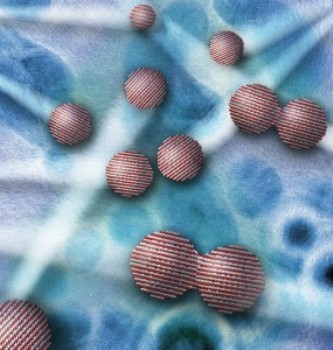A research team led by Jim DeYoreo from the Lawrence Berkeley National Laboratory (Berkeley Lab) of the US Department of Energy has for the first time directly observed the forces behind ‘oriented attachment,’ a key phenomenon whereby adjoining nanoparticles bind with each other in a typical crystallographic orientation.
 Berkeley Lab researchers at the Molecular Foundry have elucidated important mechanisms behind oriented attachment that drives biomineralization and the growth of nanocrystals. (Image from Jim DeYoreo)
Berkeley Lab researchers at the Molecular Foundry have elucidated important mechanisms behind oriented attachment that drives biomineralization and the growth of nanocrystals. (Image from Jim DeYoreo)
In the study conducted at Berkeley Lab’s Molecular Foundry, the researchers directly observed a key phase in oriented attachment. They dubbed the key phase as ‘jump-to-contact.’ The researchers studied iron oxide nanparticles’ early crystal growth utilizing a silicon liquid cell placed on the Molecular Foundry’s high-resolution transmission electron microscope. They were able to observe nanoparticle orientations all through the growth of nanoparticles into nanocrystals.
Jim DeYoreo informed that the researchers were able to measure the forces behind oriented attachment through the direct observation of the rotational and translational accelerations related to the jump-to-contact between the nanoparticles. These nanoparticles rotated and interacted continuously until they identified a perfect lattice match whereupon an unexpected jump-to-contact took place over a distance of below 1 nm. Following the jump-to-contact, lateral atom-by-atom attachments started at the contact point. These measurements demonstrated that powerful highly-direction-specific interactions trigger crystal growth through oriented attachment.
Early stage of nanocrystal growth
The study results provide in-depth insight into oriented attachment. Better understanding the forces driving this key phenomenon will be helpful in designing future biomimetic materials, advancing environmental restoration efforts, and fabricating tree-like or branched semiconductor nanowires.
DeYoreo commented that semiconductor nanowires hold potential for use in nanoelectronics, photovoltaics, photocatalysis thanks to their capability to create natural junctions, small diameters and big surface areas. The information on the mechanisms controlling the branching of nanowires will be helpful for materials scientists to design highly efficient techniques for fabricating these materials.